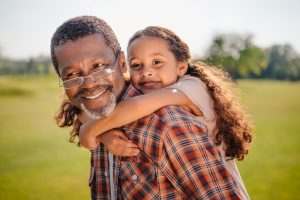Healthy Boomer
By Peggy Edwards
The joy of hugging
Are we losing touch? Have we become so attached to our phones and virtual communication that we forget the importance of reaching out and physically touching someone?

Unfortunately, the COVID-19 pandemic has severely limited our ability to hug. This lack of physical touch — hugging friends and family members — has for me, been the worst outcome of the pandemic. I have heard the same thing from many others, especially those who live alone and do not have a live-in partner to hug and touch. Grandparents and grandchildren especially miss hugging and cradling each other. In fact, when governments announce a “stay-at-home and social distance” order, often the first question asked is, “When will I be able to hug my grandchildren?”
Hugs each day keeps the doctor away
Hugs are more than just a friendly greeting — they can be a surprisingly powerful health booster.
Research shows that hugging has many health benefits to your physical and mental health. It has a positive effect on heart rate and blood pressure because it lowers levels of the stress hormones. Frequent hugs help strengthen the immune system.
Human touch signifies bonding and social connection. Hugging our loved ones promotes healthy emotional attachment and intimacy, which is the foundation of a happy, healthy long-term relationship. When you hug or touch the shoulder or hold the hand of someone who is suffering or sad, you communicate that you care in a far more effective way than words alone can do. Hugging reinforces your ability to give and receive love.
Hugging can be critical to emotional well-being and actually helps release serotonin — our own natural anti-depressant, and the hormone oxytocin, which promotes relaxation and may play a role in your ability to trust and be trusted.
Indeed, physical touch can even be critical to physical and emotional survival. Hugging and touching early in life are necessary for parent-child bonding and the child’s development of self-worth
and happiness. Babies and young animals that are deprived of physical touch may experience a failure to bond and become so depressed they stop eating — a condition called ‘failure to thrive.’
Some hugging essentials
(Warning: not always appropriate during an infectious disease pandemic)
I come from a family of huggers and believe hugging is good for us, especially as we grow older. Every time I entered the house my 80-year old Dad would rise from his chair, walk painfully with his cane to the front door to give me a big hug of greeting and love. I remember how it felt to hug my aging Mom. Even though her dementia prohibited her from always knowing my name, I could feel her relax and communicate when we hugged. As a grandparent, one of my happiest moments was when 15-year old Travis smothered me with a muddy hug when I showed up at his high school football game — in front of his friends and teammates no less!
But, about 15 per cent of people do not like to hug. They may be shy or or feel embarrassed or have experienced abuse or a lack of physical affection growing up. This must be respected. Never offend a person’s sense of personal space and safety by grabbing and hugging someone you do not know well (including family members). Ask if she or he feels comfortable with and wants to hug. This guideline applies to children as well as adults and even dogs. Ask the parents and dog-owner if it is okay to hug a child or pet a dog.
Here are some hugging essentials to know:
Men and women like to hug for many of the same reasons, but they rank those reasons differently. Women place more emphasis on feeling close, connected and important. Men like the smell and warmth and sexual excitement of a hug, feeling calmer and like they have a real friend. Both men and women rank “feeling welcome, secure and loved” near the top of their lists.
Generally, dogs love to be hugged and petted. Cats — not so much. Like people, you can only hug cats when they want to be hugged. It is satisfying and comforting to hug and stroke a pet, especially for children and older people who live alone.
Don’t be afraid to ask for a hug. Say “I need a hug” or “Can I have a hug please?” Or use the non-verbal approach. Stand in front of the person with outstretched arms. If they are comfortable with it, they will welcome a hug too.
While heart-to-heart hugs are what we most commonly do, there are other ways to hug. You can hug side-to-side. For example, sit close beside someone in a restaurant with hips and legs together; put an arm around your partner if you are looking for a romantic hug. Stand up and cheer with joined hands at an event (a sports hug). Holding hands and up-close dancing are other forms of hugging.
Research suggests that a 20-second hug is best for releasing positive hormones that relieve pain and make you feel better. But 20 seconds is a long-time with people outside of your loving circle. Hugs of greeting, goodbye and “I miss you,” can be much shorter and still feel good.
Hugging in the wake of the pandemic We have seen that physical distancing, wearing masks in public places, rigorous handwashing, and refraining from hugging and kissing are effective and
essential ways to slow and control the spread of COVID-19. So, what are we to do about hugging at a time when we must comply with these rules?
Until the pandemic is over, reserve your hugs for family and friends in your social bubble. These are people in your household and additional people you have added to your bubble, such as grandchildren and their parents, other relations and special friends — up to a maximum of 10.
If you plan to visit or meet with other family members or special friends who are not in your current bubble, get a COVID test before your visit so all of you will feel comfortable.
ALWAYS ask people if they feel comfortable with a physical hug.
Share sincere “air” hugs, kisses and waves from a proper distance or by Internet (e.g. Facetime or Zoom).Send hugs, kisses and emojis with your emails, texts and letters.
Use the phone to tell people of all ages that you love and care for them; close your eyes and share a quiet 10-second hug.
When you are feeling lonely or down, tell friends and family members that you need a virtual or phone hug, or an in-person hug from someone in your social bubble.
Finally, consider the words of Margaret Atwood:
“What’s been created during this absence of human touch is a nurturing of compassion. As we’ve learned from history, strife opens hearts. Let’s use this physical distancing, this debilitating worry
and fear as a way to ignite a fresh start — with one another and with our planet. Let’s think of it as a reset button. It gives us time to ponder what sort of world we want to be living in on the other side of this.”
I want to live in a world where I can hug and be hugged every day, where we can shake hands, touch and dance. But meanwhile, I will hug judiciously when it is safe to do so. And I will ponder how I can do my part to make a better world for the next generation — one that is guided by love, compassion and caring, the very things that hugging symbolizes.
Peggy Edwards is a well-known writer and speaker on aging and health and is a co-author of The Healthy Boomer: A No Nonsense Midlife Health Guide for Women and Men, The Juggling Act: The Healthy Boomer’s Guide to Achieving Balance in Midlife, and Intentional Grandparenting A Boomer’s Guide, all available at amazon.ca
How about you? Are you a hugger? Are you missing hugs? We’d love to hear about your hugging experiences, thoughts and feelings. Write to me at wanderingpeggy@me.com






